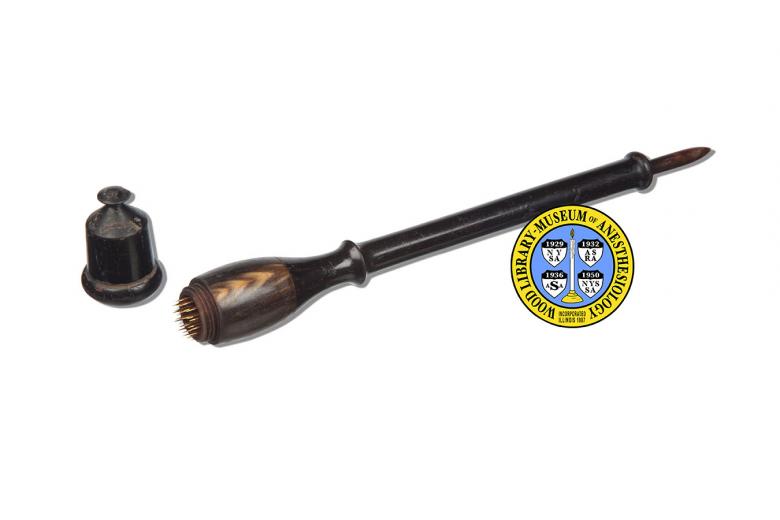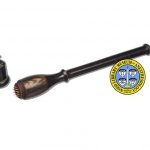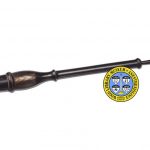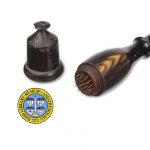Baunscheidt’s Lebenswecker
Counterirritation is an ancient technique, also used in homeopathy. It induces inflammation in one spot for the purpose of relieving it in another. This might be done by rubbing a counterirritant substance (such as pepper or camphor) onto the skin, or inserting it under the skin by means of needles.
The German inventor, Carl Baunscheidt (1809-1873) introduced his Lebenswecker ("life awakener") in 1847. The inspiration for this device came when he noticed that pain in his arthritic hand was eased after gnats had bitten him there. He theorized that the gnats bit an opening in the skin and injected an irritant that stimulated drainage of disease-causing substances through the skin.
The needles of the Lebenswecker were dipped in a proprietary counterirritant oil, and then used to puncture the skin in the selected location. This produced a rash with draining blisters. Baunscheidt called his treatment “Baunscheditismus”, or “The Exanthematic Method”, and claimed that it would cure numerous diseases. Also called a “resuscitator” or “vitalizer”, versions of the instrument were in common use from 1860 to the early 1900s. Many believed that the drainage was proof of the release of pernicious substances from the body. Compare this to the Chinese practice of qixingzhen therapy.
Catalog Record: Baunscheidt’s Lebenswecker
Access Key: akhk
Accession No.: 1999-03-18-1
Title: [Lebenswecker / Carl Baunscheidt].
Author: Baunscheidt, Carl, 1865-1875.
Title variation: Alt Title
Title: Baunscheidt’s lebenswecker.
Publisher: [Place of manufacture not indicated] : [Name of manufacturer not indicated], [1850-1920].
Physical Descript: 1 counter irritation apparatus : wood, metal ; 3 x 3 x 28 cm.
Subject: Complementary Therapies – instrumentation.
Subject: Counterirritation – instrumentation.
Note Type: General
Notes: Title based on the name given by the original designer, Carl Baunscheidt.
Date range for the possible year of manufacture based on dates the object was
found to be most heavily references in publications. The date range could
change if documentation indicates the range should be corrected.
Note Type: Citation
Notes: Baunscheidtism [advertisement]. In: Minutes of the Forty-Eighth Annual
Session of the North Ohio Conference of the Methodist Episcopal Church.
Cleveland: Leader Printing Company; 1887:103.
Note Type: Citation
Notes: Burnett JA. Baunscheidtism. Med Summ. 1912;34(7):206-207.
Note Type: Citation
Notes: Cook MM. Baunscheidtismus. Am J Clin Med. 1911;18(1);98-99.
Note Type: Citation
Notes: The exanthematic method of cure [advertisement]. Express Gaz. 1895;20(1):4.
Note Type: Citation
Notes: Exanthematic remedies [advertisement]. Express Gaz. 1895;20(5):117.
Note Type: Citation
Notes: The exanthematic method of cure [advertisement]. Minutes of the Fifty-First
Annual Session of the North Ohio Conference of the Methodist Episcopal Church
Cleveland: Cleveland Printing and Publishing Co.; 1890:
Note Type: Citation
Notes: Haller JS. Diversions, spirits, and other nonessentials. In: The History of
American Homeopathy: The Academic Years, 1820-1935. New York: Pharmaceutical
Products Press; 2005:245-247.
Note Type: Citation
Notes: Whorton JC. The holistic health explosion: acupuncture. In: Nature Cures: The
History of Alternative Medicine in America. Oxford: Oxford University Press;
2002: 260-264.
Note Type: Physical Description
Notes: A device with a shaped cylindrical body of wood, stained dark brown,
measuring approximately 20.3 long, 2.9 cm at the proximal end, and 1.7 cm at
the distal end; Inside the cylindrical body a metal piece moves within the
proximal end so that approximately 30 gold colored needles protrude
approximately 3 cm beyond the proximal opening and when pulled back the
needles retract completely from the distal opening; The needles are gold in
color; The movement of the needle head is controlled by a 4.4 cm piece of
wood that protrudes from the distal end of the cylindrical body, and measures
approximately 6 mm in diameter and comes to a point at the distal end; The
spring function that once forced the needle head to quickly protrude and then
retract is not longer functioning; For when not in use, a wooden cap screws
onto the proximal end of the device.
Note Type: Reproduction
Notes: Photographed by Mr. Steve Donisch on January 15, 2013.
Note Type: Historical
Notes: The object pictured here is but one example of the numerous remedies ailing
people have used in attempt to free themselves from the discomforts of
illness. The lebenswecker was employed in a system of treatment called
“Baunscheidtismus” or “The Exanthematic Method”. This practice, fairly common
from 1860 to the early 1900s, was invented in the late 1840s by a German
mechanic, Carl Baunscheidt (1809-1873). As told by Baunscheidt, the
inspiration for the device came when he noticed that pain in his arthritic
hand was eased after gnats had bitten him there. He theorized that the gnats
bit an opening in the skin and injected an irritant that stimulated the
drainage of disease-causing substances through his skin. Baunscheidt claimed
that the application of his proprietary oil, in conjunction with punctures of
the skin by means of the lebenswecker, cured illnesses through the same
mechanism.
Also referred to as a “resuscitator” or “vitalizer,” the
lebenswecker was designed with a circular head in which approximately 30 fine
needles were embedded. A spring was fastened to the needle-head so that when
released it drove the needles about 3 mm deep into the patient’s skin. The
skin punctures and oil produced a rash with draining blisters or pustules.
Many believed that the fluid from the blisters or oozing rash was proof of
the release of pernicious substances from the body. Generally the treatment
was repeated every two weeks or so until the ailment was cured.
Advertisements by an American maker of lebensweckers and accompanying oil,
John Linden, claimed this method to be, “A Certain Cure For All Diseases.”
Note Type: Exhibition
Notes: Chosen for the WLM website (noted June 10, 2013).




